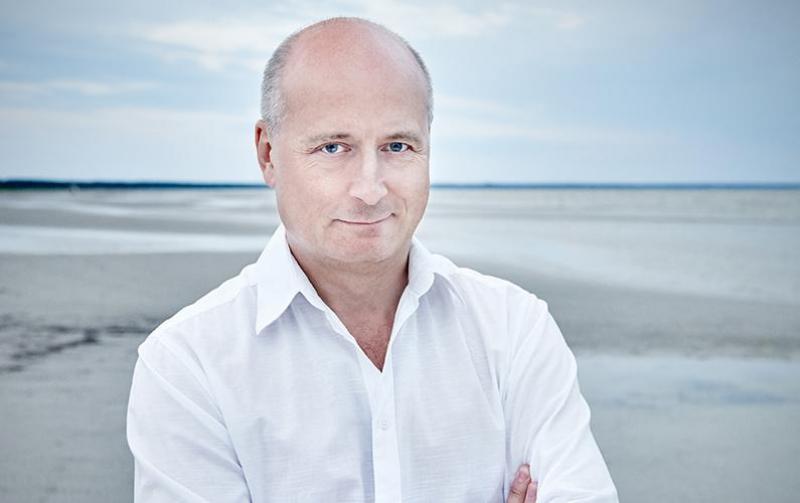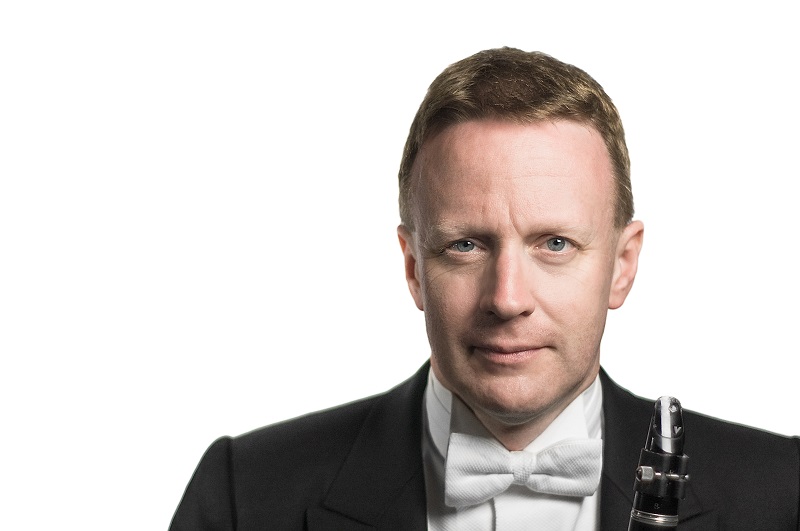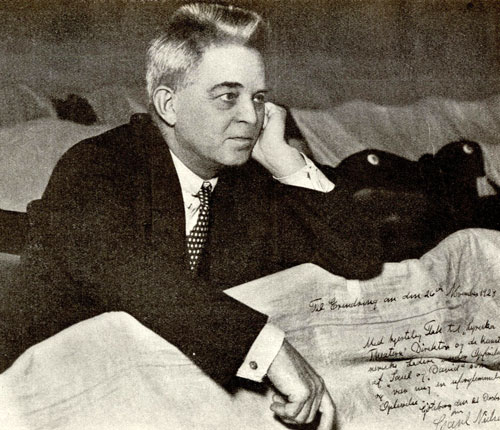Van de Wiel, Philharmonia, Järvi, RFH | reviews, news & interviews
Van de Wiel, Philharmonia, Järvi, RFH
Van de Wiel, Philharmonia, Järvi, RFH
Performances of Nielsen and Haydn that needed more orchestral focus

“Choleric humour, pathos and kindliness are mingled in conflict," wrote Robert Simpson of Nielsen’s 1928 Clarinet Concerto. The work was written for a player with a complex character, full of contradictions. Last night’s soloist, Mark van de Wiel, the Philharmonia's principal clarinettist, gave a fluent performance of the work convincing on its own terms, portraying the protagonist as an introvert and anti-hero.
There are performances which bring to the fore much more of the humour, the tendency to cajole and tease that are there in this work. This one was firmly fixed on its darker side. Particularly successful were the irascible episodes where the soloist is spurred to gruffness and anger by the provocations of a side drum – played by the excellent and characterful Matt Prendergast, one of no fewer than 10 guest principals on stage last night.
 Paavo Järvi (main picture) also brought out the accented folk dance rhythms well, causing the soloist at one point to a visible physical reaction - an almost involuntary shimmy, a rare moment of cheerfulness. The ending, where the soloist finally finds calm, was convincing from him, and yet a disappointment overall. The upper strings somehow failed to give van de Wiel (pictured right) enough of the tendernesss and solace that is clearly there in the string writing; their phrases were lacking in both pathos and definition.
Paavo Järvi (main picture) also brought out the accented folk dance rhythms well, causing the soloist at one point to a visible physical reaction - an almost involuntary shimmy, a rare moment of cheerfulness. The ending, where the soloist finally finds calm, was convincing from him, and yet a disappointment overall. The upper strings somehow failed to give van de Wiel (pictured right) enough of the tendernesss and solace that is clearly there in the string writing; their phrases were lacking in both pathos and definition.
The absence of convincing shape to the string phrasing was also a feature which compromised the opening work, Haydn’s Symphony No. 83 in G minor. There were lightness, humour and efficiency in the outer movements, but the Andante lacked both lyricism and depth.
 The work in the second half was Nielsen’s Third Symphony of 1910-11, the Espansiva. This performance brought to mind the pull-out quote which Paavo Järvi’s management have put very prominently on his page on their website, as his calling card: “Järvi clearly prizes highly charged music making, often at top speed, with thoughtful phrasing and sharply punched accents… these qualities yield refreshing, powerful performances.” Järvi has gestures – the underarm sweep, the forward lunge, the stamping foot - which whip up the orchestra to a blazing tutti.
The work in the second half was Nielsen’s Third Symphony of 1910-11, the Espansiva. This performance brought to mind the pull-out quote which Paavo Järvi’s management have put very prominently on his page on their website, as his calling card: “Järvi clearly prizes highly charged music making, often at top speed, with thoughtful phrasing and sharply punched accents… these qualities yield refreshing, powerful performances.” Järvi has gestures – the underarm sweep, the forward lunge, the stamping foot - which whip up the orchestra to a blazing tutti.
When all 13 brass players were going for it, the sound was glorious. There were sections, such as the eight-strong bass contingent, which responded with unanimity and presence. Todd Gibson-Cornish as principal bassoon was highly effective throughout. But there were moments when expectations were unfulfilled, such as when Järvi was cajoling the horns which Nielsen (pictured above left in the year of the Clarinet Concerto, 1928) often uses to herald the transition to a new temperament. This performance ran the risk of becoming just a series of highlights: when the intensity was pulled back, the orchestra's focus and purpose became less distinct.
rating
Share this article
The future of Arts Journalism
You can stop theartsdesk.com closing!
We urgently need financing to survive. Our fundraising drive has thus far raised £49,000 but we need to reach £100,000 or we will be forced to close. Please contribute here: https://gofund.me/c3f6033d
And if you can forward this information to anyone who might assist, we’d be grateful.

Subscribe to theartsdesk.com
Thank you for continuing to read our work on theartsdesk.com. For unlimited access to every article in its entirety, including our archive of more than 15,000 pieces, we're asking for £5 per month or £40 per year. We feel it's a very good deal, and hope you do too.
To take a subscription now simply click here.
And if you're looking for that extra gift for a friend or family member, why not treat them to a theartsdesk.com gift subscription?
more Classical music
 Anja Mittermüller, Richard Fu, Wigmore Hall review - a glorious hall debut
The Austrian mezzo shines - at the age of 22
Anja Mittermüller, Richard Fu, Wigmore Hall review - a glorious hall debut
The Austrian mezzo shines - at the age of 22
 First Person: clarinettist Oliver Pashley on the new horizons of The Hermes Experiment's latest album
Compositions by members of this unusual quartet feature for the first time
First Person: clarinettist Oliver Pashley on the new horizons of The Hermes Experiment's latest album
Compositions by members of this unusual quartet feature for the first time
 Gesualdo Passione, Les Arts Florissants, Amala Dior Company, Barbican review - inspired collaboration excavates the music's humanity
At times it was like watching an anarchic religious procession
Gesualdo Passione, Les Arts Florissants, Amala Dior Company, Barbican review - inspired collaboration excavates the music's humanity
At times it was like watching an anarchic religious procession
 Classical CDs: Camels, concrete and cabaret
An influential American composer's 90th birthday box, plus British piano concertos and a father-and-son duo
Classical CDs: Camels, concrete and cabaret
An influential American composer's 90th birthday box, plus British piano concertos and a father-and-son duo
 Cockerham, Manchester Camerata, Sheen, Martin Harris Centre, Manchester review - re-enacting the dawn of modernism
Two UK premieres added to three miniatures from a seminal event of January 1914
Cockerham, Manchester Camerata, Sheen, Martin Harris Centre, Manchester review - re-enacting the dawn of modernism
Two UK premieres added to three miniatures from a seminal event of January 1914
 Kempf, Brno Philharmonic, Davies, Bridgewater Hall, Manchester review - European tradition meets American jazz
Bouncing Czechs enjoy their Gershwin and Brubeck alongside Janáček and Dvořák
Kempf, Brno Philharmonic, Davies, Bridgewater Hall, Manchester review - European tradition meets American jazz
Bouncing Czechs enjoy their Gershwin and Brubeck alongside Janáček and Dvořák
 Solomon, OAE, Butt, QEH review - daft Biblical whitewashing with great choruses
Even a top soprano and mezzo can’t make this Handel paean wholly convincing
Solomon, OAE, Butt, QEH review - daft Biblical whitewashing with great choruses
Even a top soprano and mezzo can’t make this Handel paean wholly convincing
 Two-Piano Gala, Kings Place review - shining constellations
London Piano Festival curators and illustrious friends entertain and enlighten
Two-Piano Gala, Kings Place review - shining constellations
London Piano Festival curators and illustrious friends entertain and enlighten
 Echo Vocal Ensemble, Latto, Union Chapel review - eclectic choral programme garlanded with dance
Beautiful singing at the heart of an imaginative and stylistically varied concert
Echo Vocal Ensemble, Latto, Union Chapel review - eclectic choral programme garlanded with dance
Beautiful singing at the heart of an imaginative and stylistically varied concert
 Scott, Irish Baroque Orchestra, Whelan, RIAM, Dublin review - towards a Mozart masterpiece
Characteristic joy and enlightenment from this team, but a valveless horn brings problems
Scott, Irish Baroque Orchestra, Whelan, RIAM, Dublin review - towards a Mozart masterpiece
Characteristic joy and enlightenment from this team, but a valveless horn brings problems
 Classical CDs: Voice flutes, flugelhorns and froth
Baroque sonatas, English orchestral music and an emotionally-charged vocal recital
Classical CDs: Voice flutes, flugelhorns and froth
Baroque sonatas, English orchestral music and an emotionally-charged vocal recital

Add comment